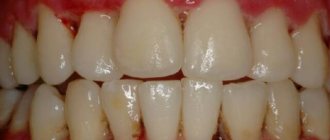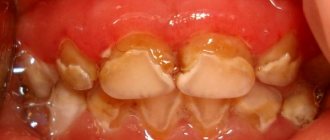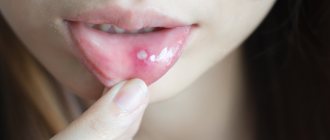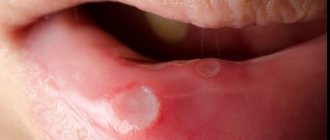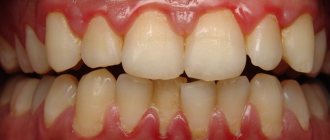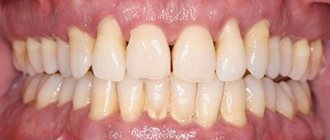Gingivitis is easily suspected by the changed appearance of the gums and the appearance of bad breath. The disease develops with inflammation of the gum edges above the teeth and interdental papillae. An increase in the size of gum tissue is periodically diagnosed. Left unattended, gingivitis can develop into periodontitis, and then there is a risk of tooth loss due to changes in the bone.
Dentists distinguish three forms of gingivitis:
- Catarrhal;
- Ulcerative-necrotic;
- Hypertrophic.
Catarrhal gingivitis
Most often, patients come to see a doctor with this form of pathology. The inflammation is mainly caused by poor oral hygiene and the accumulation of plaque near the edges of the gums. However, hypovitaminosis, blood diseases, pregnancy and a number of other conditions also lead to a similar result.
As long as gingivitis has not worsened, teeth cleaning to remove plaque can be done at home without visiting a doctor. If there are no positive changes, you will still have to go to the clinic, but you can start with simple steps:
- Sanitation of the oral cavity with rinses;
- Application of medicinal gels;
- Using special toothpastes.
Therapy takes 10 days; decreasing or increasing the duration is contraindicated. The gums are treated as standard, twice a day: after waking up and before going to bed.
Rinsing
After breakfast and brushing your teeth, you will need to disinfect your mouth with Chlorhexidine. The drug purchased at the pharmacy does not need to be diluted. You are supposed to take it into your mouth, hold it, trying to wash the internal tissues, and then spit it out. The procedure takes a minute, no more and no less. Remember: Chlorhexidine should not be swallowed! The taste of the liquid is also not very pleasant. If there is concern that accidental swallowing will occur or the taste causes rejection, it is permissible to replace it with a softer Miramistin. It is more expensive, but does not cause harm if it enters the esophagus.
Lubricating gums with gel
It is recommended to use Cholisal or MetrogilDenta gel. The first one is preferable. The latter is purchased if Kholisal is not available.
After rinsing, you will need to dry the gums for high-quality adhesion of the gel to living tissues. It is best to blot the mucous membrane with a clean piece of cotton cloth or a sterile bandage.
Wash your hands with soap, squeeze the gel onto your index finger, wait a couple of seconds until the drug warms up a little. Then, with gentle massaging movements, apply first to the outer part of the gum, then move to the inner part. There is no need to rub until it disappears.
After treatment, it is forbidden to eat for three hours and drink for half an hour. You can swallow saliva without restrictions. There is even a slight increase in salivation due to the anise in the gel. An identical procedure is performed at night.
Brushing teeth for gingivitis
The described procedures for getting rid of catarrhal gingivitis are not enough. The insidious pathology willingly returns, you just need to slightly weaken your oral care. The plaque progresses, hardens, tartar destroys the teeth and inflames the gums. Caries will add to the trouble, so suspicious teeth should be checked by a dentist and treated if necessary.
Often a person who notices bleeding gums gets scared and stops hygienically cleaning their teeth. Such a step is considered wrong; the problem will only get worse. Having seen alarming symptoms, it is recommended to replace the toothbrush during the therapeutic procedures, choosing soft bristles. Now there are many brands and varieties on sale, we recommend paying attention to the inscriptions associated with dental diseases. For example, Parodontax.
For the treatment of gingivitis, dentists recommend choosing toothpastes with plant extracts and aluminum lactate in the composition: Biocalcium (Splat), Lacalut Active, Active Clinical, etc. Read the list of indications, look for mention of the fight against bleeding of the mucous membrane, gingivitis, periodontitis.
Ulcerative-necrotizing gingivitis
Otherwise, the disease is called Vincent ulcerative-necrotizing gingivitis. It occurs acutely or occurs chronically.
The source of the development of the disease is said to be a sharply increasing amount of bacterial plaque at the border of the gums and tooth enamel, with a predominance of spirochetes and fusobacteria in the biomass. In this case, there is an initial ulceration of the mucous membrane, and then the tissues die. The provocateurs of ulcerative gingivitis are often a decline in immunity and serious illnesses with a chronic clinical picture.
The acute form is accompanied by high fever and bleeding from under the gums. Loss of appetite, the smell of rotting flesh emanates from the mouth. The gums look affected, with ulcers, the interdental papillae acquire a gray tint and become necrotic. In a chronic course, the same thing happens, but the picture is blurred and not expressed so intensely. Changes are developing gradually.
It is impossible to treat ulcerative gingivitis at home; a visit to the dentist is required to establish a diagnosis and prescribe antibiotic drugs. Dental plaque is removed using professional means. It will not do without applications and rinses. To regenerate the mucous membrane, active gels are prescribed, for example Solcoseryl.
Tests to diagnose gingivitis
The Schiller-Pisarev test is based on identifying the volume of glycogen in the gum. If the gums are healthy, then glycogen is not contained in it, but in the presence of an inflammatory process it appears and increases depending on the degree of inflammation. Schiller-Pisarev solution is an indicator that colors the gums in various shades of brown, depending on the strength of the inflammatory process. Using this test, a diagnosis of gingivitis or periodontitis can be made.
Hypertrophic gingivitis
The essence of the disease is reflected in the name - the gums and gingival papillae grow and become oversized. This occurs either through tissue swelling or due to internal proliferation of connective tissue with the formation of scars - fibrosis.
Accordingly, hypertrophic gingivitis can be edematous and fibrous.
The incentives are:
- Hormonal changes in the body during pregnancy;
- Injury to the gums by the edges of dentures and crowns;
- Progression of catarrhal gingivitis;
- Changes in hormonal levels during adolescence.
Edema form of gingivitis
This type of disease is often associated with internal changes in metabolism in women and growing children. The interdental papillae look loose and engorged. At the beginning of treatment, the oral cavity is sanitized, plaque and stones are removed, then anti-inflammatory procedures begin.
Sclerotization is most often used. After applying anesthesia, a special solution containing calcium chloride, magnesium sulfate and glucose is injected into the patient’s gums. The course takes 6-8 days with one or two day breaks.
Advanced swelling of the gums can change; the patient’s mucosa becomes scarred with the formation of fibrous cords.
Fibrous form of gingivitis
The source of troubles are internal changes in living tissues. Surgery is indicated here; unfortunately, fibrosis is not amenable to conservative therapy. First, external irritants are corrected - tartar is removed, the shape of the crown is corrected. Then the hypertrophied tissues are excised. Subsequently, healing bandages are applied.
Types of gingivitis
Based on how the disease progresses, the following types of gingivitis are distinguished:
- Acute - when it appears suddenly and its course sharply intensifies.
- Chronic - the inflammatory process proceeds slowly and the condition worsens gradually.
- Aggravated gingivitis - an increase in symptoms of chronic inflammation.
- Gingivitis in remission is a state of subsidence of symptoms.
According to the form, it is customary to distinguish the following types of gingivitis:
- catarrhal, manifested by swelling and redness of the gums;
- ulcerative, when dead areas of gum appear;
- hypertrophic, characterized by a sharp increase in gums and bleeding;
- atrophic, manifested in thinning of the gums;
- desquamative, characterized by redness and severe detachment of the upper layer of the mucosa.
According to the degree of prevalence in the oral cavity, gingivitis is divided into local (partial) and generalized (extensive).
Gingivitis: treatment at home
Gingivitis can result not only from the accumulation of plaque on the edge of the gum due to the use of inappropriate hygiene products, but also develops due to internal problems in the body. At home, it is quite possible to combat the results of the initial stages of catarrhal gingivitis, but you will not be able to get rid of stones with rinses and prepared solvents. You still have to sit in the doctor's chair.
In addition, self-medication of ulcerative or hypertrophic gingivitis is unacceptable. There is an extremely high risk of harming a person and worsening the patient’s condition.
Doctors also advise critically perceiving information about miracle cures presented in advertising. The phrase “Specialist consultation required,” which is now demonstrated in every video, took a lot of persistence from doctors. The fact is that any product is advertised as effective, but it is not specified that we are talking about symptomatic effects. The patient will be able to get rid of the symptoms, but the advertising product is not able to cure the cause that causes them - periodontal plaque, mineralized deposits. Therefore, consultation with a professional is absolutely required.
Causes
Chronic hypertrophic gingivitis is accompanied by active growth of basal cells of the gingival epithelium. The occurrence of the disease can be caused by congenital malocclusions or low attachment of the frenulum, as well as the presence of low-quality dentures, fillings, and dental plaque.
Some common factors also contribute to the occurrence of the disease:
- the presence of chronic diseases of the nervous and endocrine systems;
- long-term use of medications, including antibiotics and hormonal drugs;
- lack of vitamin C in the patient’s body, which is responsible for gum health;
- the presence of hormonal imbalance, including during pregnancy.
Mechanical trauma to the gums from a tooth fragment, poorly fitting filling or prosthesis can also cause the disease.
Most often, the disease is localized on the upper jaw, in the frontal area.
Treatment with folk remedies
All “grandmother’s” advice for gingivitis is of an auxiliary nature. You cannot refuse traditional treatment, relying on “time-tested recipes.” This is not stated anywhere, but in ancient times, people, using exclusively natural raw materials, lost their teeth extremely early - by modern standards. It is worth taking advantage of the achievements of science to preserve a beautiful and healthy smile for many years.
As maintenance therapy, it is allowed to use rinses with tinctures and decoctions of herbs (excluding alcohol). Chamomile, St. John's wort, and eucalyptus are beneficial. A side effect of this treatment will be rapid darkening of tooth enamel. Therefore, special herbal remedies produced on an industrial scale will be a worthy alternative to home preparations.
Laser gingivotomy - surgical treatment of complex forms of periodontitis
Catarrhal and hypertrophic gingivitis symptoms and treatment in adults
The roots of the teeth are exposed - what to do and how to treat them
Laser gingivectomy in the area of one tooth
Treatment of generalized moderate and severe periodontitis
Splinting teeth for periodontitis with fiberglass and tape
Where to treat?
By contacting the Good Hands clinic, you can undergo diagnosis and treatment of catarrhal gingivitis using modern techniques and effective drugs. Our specialists have extensive experience in successfully treating this disease and give a positive prognosis in the vast majority of cases when promptly seeking professional dental care. You can sign up with us for a free consultation if you are concerned about certain symptoms and find out whether we have the disease or how to exclude its development.


